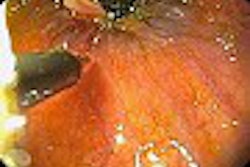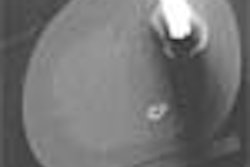With the aid of CT-guided radiofrequency ablation, researchers in Italy have successfully treated primary lung cancer in 35 patients whose tumors had been deemed inoperable. While avoiding the term "cure," the researchers found that many lesions shrank, many smaller ones disappeared, and that clinical symptoms improved in many patients in follow-up imaging and histologic exams ranging from six months to a year.
Surgery is the treatment of choice for primary stage I lung cancer, but many patients are considered ineligible for resection because of poor cardiopulmonary status or poor general health, wrote Drs. Giuseppe Belfiore, Giovanni Moggio, Enrico Tedeschi, and colleagues from the San Sebastiano Caserta's Hospital in Caserta, Italy. Researchers have long sought additional treatment options in such patients, for whom chemotherapy and radiotherapy has been considered insufficient.
"After animal studies proved the thermal effects of radiofrequency energy in lung tissue and its capability in the treatment of small pulmonary masses, radiofrequency tumor ablation began to be applied in animal models," the authors wrote in the October issue of the American Journal of Roentgenology. "The aim of this study was to evaluate the effectiveness, safety, technical feasibility and complications of CT-guided tumor ablation with radiofrequency in the treatment of nonsurgical primary pulmonary malignancies as a possible alternative or complementary treatment to radio- or chemotherapy for palliation of the major symptoms of lung cancer (pain, cough, dyspnea). In addition, we sought to assess in vivo the effects of radiofrequency on the neoplastic tissue by performing fine-needle aspiration biopsy or core biopsy six months after the radiofrequency treatment" (AJR, October 2004, Vol. 183:4, pp. 1003-1011).
To this end, the team recruited 33 patients (26 men and 7 women ages 44-75) with unresectable malignant lung lesions. The cases included 21 cases of adenocarcinoma, 11 squamous cell carcinomas, and one small cell carcinoma. Group 1 included 12 patients with tumors smaller than 3 mm (none were smaller than 1.5 mm), group 2 included 19 patients with 3-5 cm tumors, and group 3 included two patients with tumors larger than 5 mm.
Pretreatment sedation and medication routinely consisted of midazolam (0.04 mg/kg), tramadol hydrochloride (50 mg), and atropine (0.5 mg/kg), the authors wrote. A local anesthetic consisting of Carbocaina (5-10 mL mepivacaine, AstraZeneca) and Naropin (ropivacaine hydrochloride) was administered immediately before the RF probe was inserted.
Contrast-enhanced CT was used preprocedurally to target the lesion and determine the optimal electrode placement. Follow-up scans were also obtained immediately after the procedure, at one week, at six months (29 cases), and one year (10 cases).
The RF ablation procedures were performed using one of two systems. A Cosman Coagulator-1 (Radionics, Burlington, MA, a division of Tyco Healthcare Group) was used in 23 cases -- 19 with a cool-tip single electrode (four of which were repositioned once), and four using a cluster electrode for lesions larger than 3 cm.
In 10 cases a Starburst-compatible system (RITA Medical Systems, Mountain View, CA) was deployed using a 15-gauge multitined expandable electrode that did not require repositioning, according to the authors. In all cases, the needle was held in place until a target tissue temperature of 90-95°C was obtained and held for nine to 12 minutes.
Ablation was technically successful in all 35 cases, the authors wrote. Complications included three cases of minor pneumothorax (9%), three asymptomatic pleural effusions, sputum cruentum in five cases (14%), and three with asymptomatic pleural effusions (9%). None of the cases required specific treatment, and no later complications were seen, they added.
"In most cases, contrast-enhanced CT scans obtained immediately and one week after radiofrequency ablation showed a nonenhancing central area with decreased density (ablation zone), with intralesional bubbles and enveloped ground-glass opacity surrounding the tumor," the authors wrote.
Contrast-enhanced CT follow-up at six months showed complete lesion ablation in four cases, partial ablation in 13, 11 cases of stabilized lesion size, and one case in which lesion size increased. At six months, four patients had died from causes unrelated to the procedure, and at one year, four more patients had died from unrelated causes including heart failure, liver failures, and extrathoracic tumor growth.
"From our experience with this study, we speculate that the use of CT appearance of lung nodules after radiofrequency ablation as the only criterion for complete necrosis and success of therapy may not be sufficient," the authors wrote. "Some neoplastic cells were observed in the aspirates from low-density zones in our biopsy specimens, even in 42% (5/12) of the cases with reduced tumor size on CT at six months. We then stress the need to check the evolution of treated nodules with CT-guided histopathologic examination together with CT findings."
Ten patients were available to undergo one-year follow-up CT, which showed unchanged lesion size in six patients, and further reduction in the ablation zone in four patients compared with the six-month scans, the authors explained. Five patients with 1-cm lesions or smaller (group 1) showed complete tumor necrosis at biopsy; seven other patients with "vanishing" lesions did not undergo biopsy.
Among the clinical results, thoracic pain was completely resolved in five patients, reduced in four, and slightly increased in two, the researchers wrote. Coughing was reduced in seven patients, and six patients reported better respiratory performance.
"Radiofrequency tumor ablation has become a credible addition to the arsenal of minimally invasive cancer therapies with palliative goals," the authors wrote. "The technique is based on the premise that local disease control can have a positive effect on survival or quality of life in selected populations."
The results suggest that the best chance for a cure, beyond palliative treatment goals, appears to rest with the RF ablation in patients with small, non-oat cell lung tumors, which should be evaluated in long-term studies; the long-term benefits of the procedure are unknown in all patients. The equipment used for the procedure is expected to continue improving over time, they added.
"The extensive laboratory and animal experience, in combination with the results of preliminary clinical studies, suggests that this technique may play an important role in the treatment of patients with primary and secondary lung tumors, and the optimal combination of radiofrequency ablation with chemotherapy and radiotherapy protocols should be addressed in future studies," Belfiore and colleagues concluded.
By Eric Barnes
AuntMinnie.com staff writer
October 13, 2004
Related Reading
RFCA for afibrillation evolves with MDCT, July 23, 2004
RFA shows high success rate in lung tumor ablation, December 2, 2003
Radiofrequency ablation shows promise in treating lung cancer, May 14, 2003
Copyright © 2004 AuntMinnie.com



















